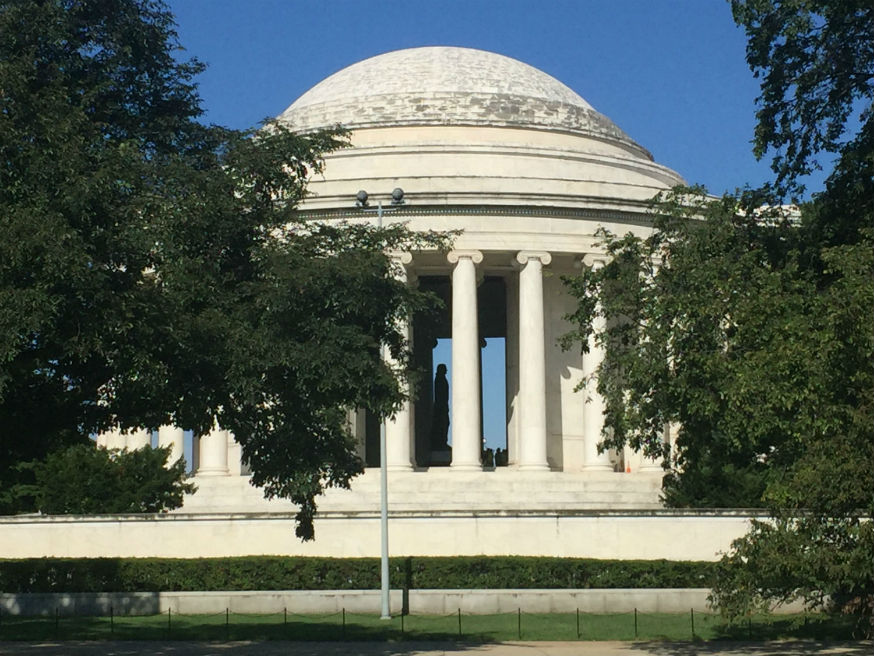|

National Park Service photo
Contact: Mike Litterst, 202-245-4676 WASHINGTON - The dome of the Thomas Jefferson Memorial is one of the iconic landmarks on the Washington, D.C. skyline. In recent years, however, the gleaming white rotunda has become increasingly darkened, but not by dirt or mold, as the casual eye might suspect. The culprit is a colony of microscopic organisms, called biofilm, which adheres to stone surfaces and is proving a challenge as the National Park Service investigates how to treat it."The increased presence of biofilm presents a new challenge in the care of memorials throughout the National Mall, particularly at the Thomas Jefferson Memorial," said Gay Vietzke, superintendent of National Mall and Memorial Parks. "We are continuing to study biofilm and research treatment methods, and look forward to restoring the dome to its original luster while ensuring its long-term preservation."
The blackening effects of biofilm are not a problem unique to the Jefferson Memorial. It can be found throughout Washington, from the Lincoln Memorial to tombstones at Congressional Cemetery, and around the world, from Hadrian's Villa in Italy to Angkor Wat in Cambodia and even on monuments in Egypt. It was successfully treated at the D.C. War Memorial in 2011.
While the study of the relationship of biofilms on buildings and the effects of cleaning them is still young, one of the common factors in the existence of many biofilms is the presence of nutrients and a place to grow, like stone. At the Jefferson Memorial, perhaps the most significant factor in its development is the erosion of the marble through natural weathering. The marble blocks that make up the Jefferson Memorial were smooth when they were originally hoisted into position, but over the years, rain has slowly eroded the marble, turning its once smooth surfaces into pitted surfaces –the perfect environment for a biofilm.
The black biofilm on the Jefferson Memorial first became noticeable in 2006 and has become increasingly more pronounced in recent years. A multi-disciplinary team of conservators, architects, and molecular biologists has been studying the growth on the Jefferson Memorial since 2014 as they prepare to test potential treatment options.
"Treatment of biofilm is difficult, as there is no known permanent method for removing it, and we have to ensure that any treatment must not do further damage to the soft marble of the memorial nor encourage further growth," said Catherine Dewey, chief of resource management for National Mall and Memorial Parks. "We are testing a variety of treatment techniques to find the option that is least damaging to the stone, safe for the environment and visitors, and cost effective."
National Park Service officials recently began testing ten different chemical biocides in small patches affected by biofilm at the base of the Jefferson Memorial and will monitor how effective each one is in the coming days and weeks. They will also experiment with more non-traditional treatment options, including ozonated water and irradiation with lasers.
There is no timeline for treatment of the dome and National Park Service officials stress that it's a deliberative process to ensure that whatever treatment is selected will do no further harm to the Jefferson Memorial. The treatment method ultimately chosen will help define the cost to restore the dome, which in turn drive the timeline for when the work will be scheduled.
NPS
About National Mall and Memorial Parks
The National Park Service's National Mall and Memorial Parks preserves, protects, and interprets the symbolic and monumental civic spaces and commemorative works in the center of the Nation's Capital that honor American ideals and values, distinguished public figures, and military and civilian sacrifices and contributions. On the National Mall these sites include the Washington Monument, Lincoln Memorial, Thomas Jefferson Memorial, Vietnam Veterans Memorial, Korean War Veterans Memorial, Franklin Delano Roosevelt Memorial, World War II Memorial, and Martin Luther King, Jr. Memorial. National Mall and Memorial Parks also serves as a public park and open space for active civic and cultural engagement, recreation, and public enjoyment.
|
Last updated: August 10, 2016
